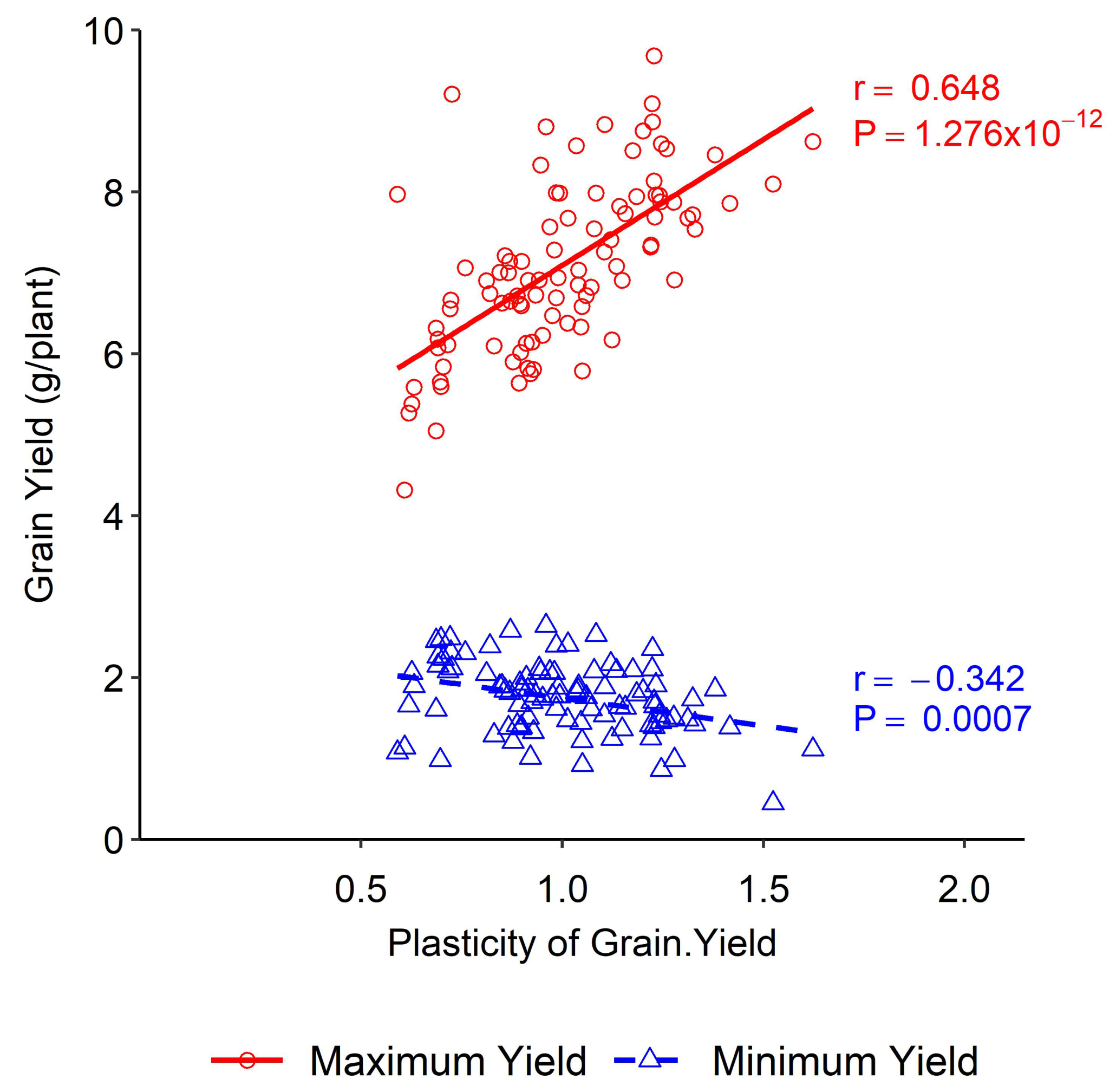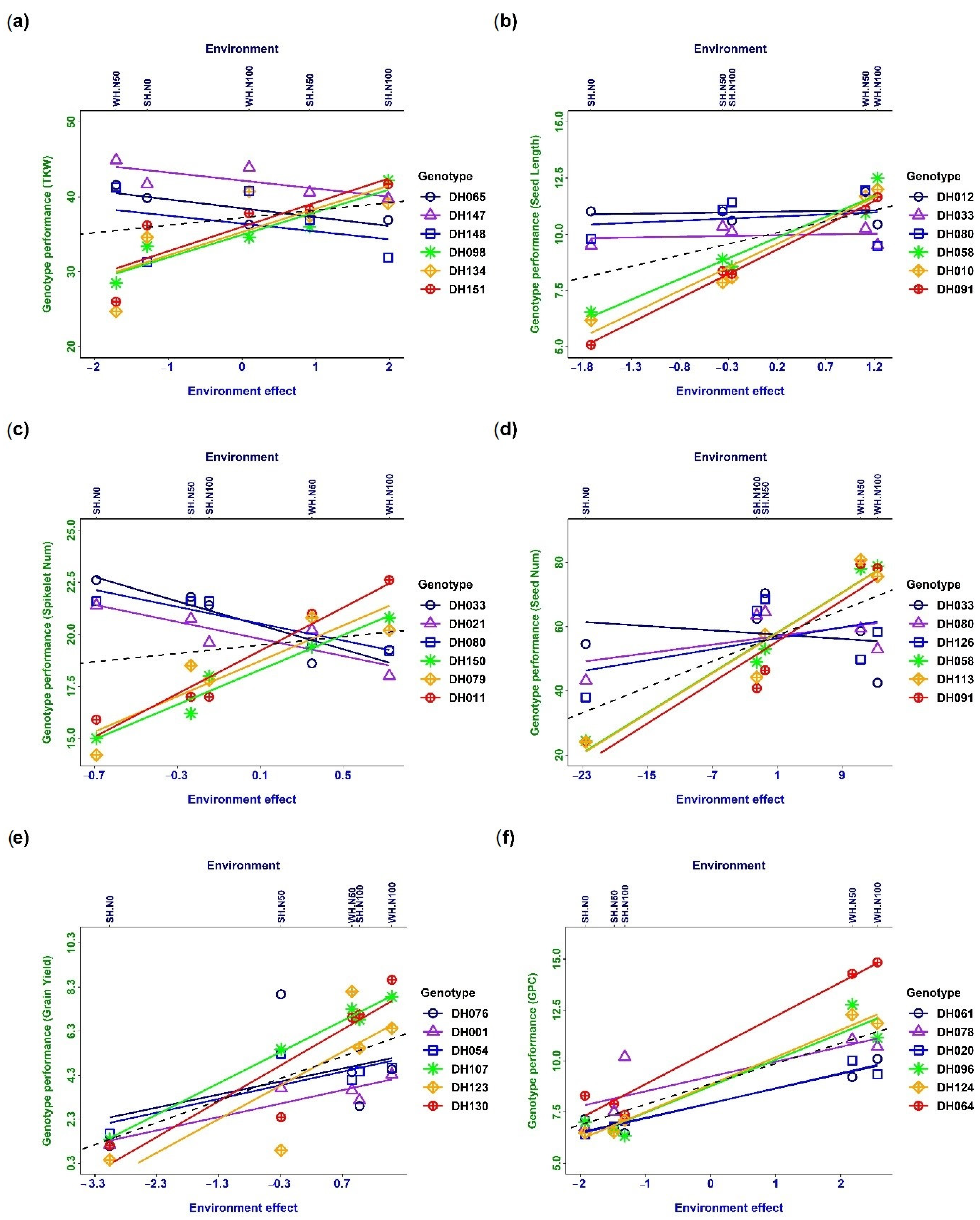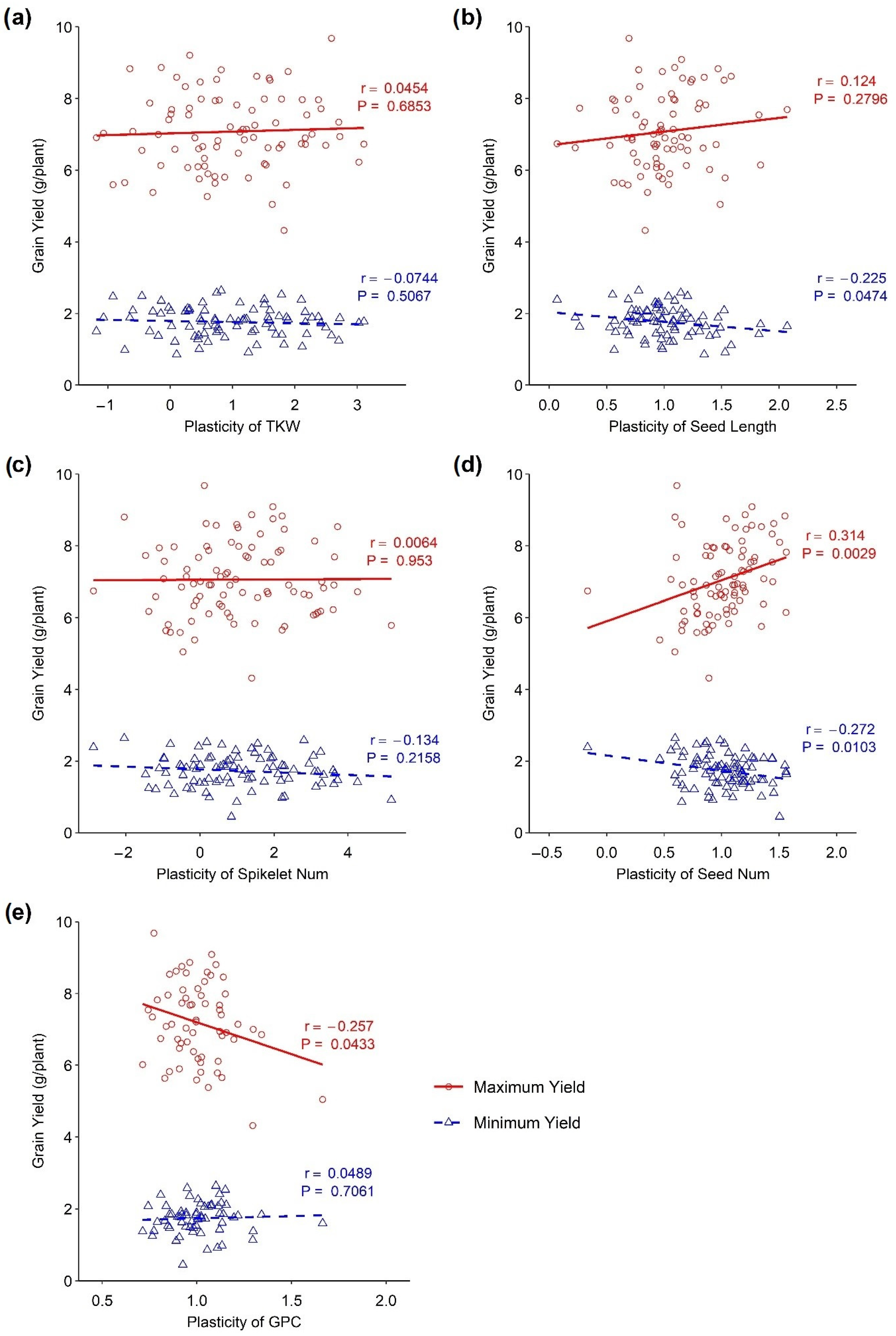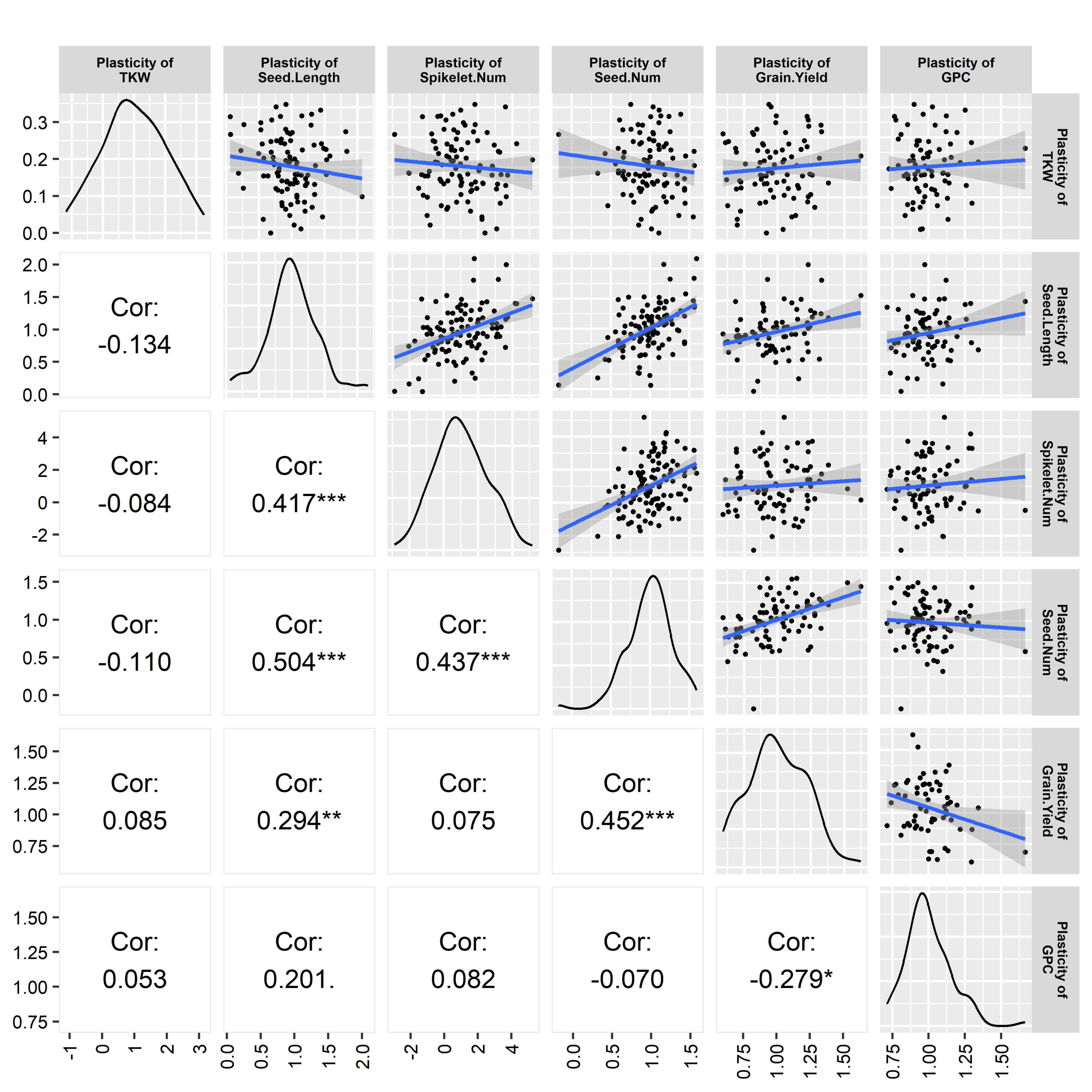Phenotypic Plasticity of Yield and Yield-Related Traits Contributing to the Wheat Yield in a Doubled Haploid Population
Abstract
:1. Introduction
2. Materials and Methods
2.1. Plant Materials
2.2. Field Trials
2.3. Phenotyping
2.4. Estimation of Plasticity
2.5. Joint Segregation Analysis
3. Results
3.1. Phenotypic Plasticity of Yield-Related Traits
3.2. Influence of Yield Plasticity on Yield
3.3. Influence of Other Traits’ Plasticity on Yield
3.4. Trait Plasticity and Genotype–Environment Interaction
3.5. Plasticity in Determining Traits’ Interrelationships
3.6. Joint Segregation Analysis of the Genes Governing Grain Yield and Yield-Related Traits
- 1MG ~ 4MG: One to four major genes.
- AE: da = db, additive effect with interactions between the two major genes.
- ER: epistatic recessiveness of aa on Bb locus.
- EA: da = db, equally additive, not considering the interaction between the two major genes.
- AI: Additive epistasis.
- CEA: da = db = dc = d, completely equally additive.
- PEA: da = db = d1, dc = d2, partially equally additive.
- EEA: da = db = dc = d1, dd = d2, partially equally additive.
- EEEA: da = db = d1, dc = dd = d2, partially equally additive.
4. Discussions
4.1. Quantification and Comparison of Plasticity of Yield and Yield Components
4.2. Genotype–Environment Interaction on Yield and Related Traits
4.3. Correlation between Yield Plasticity and Another Trait’s Plasticity
4.4. Genes Controlling Different Traits and Their Effect
5. Conclusions
Supplementary Materials
Author Contributions
Funding
Data Availability Statement
Conflicts of Interest
References
- Bradshaw, A.D. Evolutionary Significance of Phenotypic Plasticity in Plants. Adv. Genet. 1965, 13, 115–155. [Google Scholar] [CrossRef]
- Des Marais, D.; Hernandez, K.; Juenger, T. Genotype-by-Environment Interaction and Plasticity: Exploring Genomic Responses of Plants to the Abiotic Environment. Annu. Rev. Ecol. Evol. Syst. 2013, 44, 5–29. [Google Scholar] [CrossRef]
- Xue, B.K.; Leibler, S. Benefits of Phenotypic Plasticity for Population Growth in Varying Environments. Proc. Natl. Acad. Sci. USA 2018, 115, 12745–12750. [Google Scholar] [CrossRef]
- Kusmec, A.; de Leon, N.; Schnable, P.S. Harnessing Phenotypic Plasticity to Improve Maize Yields. Front. Plant Sci. 2018, 9, 1377. [Google Scholar] [CrossRef] [PubMed]
- Ghalambor, C.K.; McKay, J.K.; Carroll, S.P.; Reznick, D.N. Adaptive versus Non-Adaptive Phenotypic Plasticity and the Potential for Contemporary Adaptation in New Environments. Funct. Ecol. 2007, 21, 394–407. [Google Scholar] [CrossRef]
- Bernardo, R. Breeding for Quantitative Traits in Plants, 3rd ed.; Stemma Press: Woodbury, MN, USA, 2010; ISBN 978-0-9720724-3-4. [Google Scholar]
- Schlichting, C.D. Hidden Reaction Norms, Cryptic Genetic Variation, and Evolvability. Ann. N. Y. Acad. Sci. 2008, 1133, 187–203. [Google Scholar] [CrossRef]
- Zmieńko, A.; Samelak, A.; Kozłowski, P.; Figlerowicz, M. Copy Number Polymorphism in Plant Genomes. Theor. Appl. Genet. 2014, 127, 1–18. [Google Scholar] [CrossRef] [PubMed]
- Kalisz, S.; Purugganan, M.D. Epialleles via DNA Methylation: Consequences for Plant Evolution. Trends Ecol. Evol. 2004, 19, 309–314. [Google Scholar] [CrossRef]
- Hill, J.; Becker, H.C.; Tigerstedt, P.M.A. Genotype—Environment Interactions: Analysis and Problems. In Quantitative and Ecological Aspects of Plant Breeding; Springer: Berlin/Heidelberg, Germany, 1998; pp. 155–186. [Google Scholar] [CrossRef]
- Comstock, R.E.; Moll, R.H. Genotype x Environment Interactions. In Symposium on Statistical Genetics and Plant Breeding; National Academy Science; National Research Council: Washington, DC, USA, 1963; pp. 164–196. [Google Scholar]
- Chapman, S.C. Use of Crop Models to Understand Genotype by Environment Interactions for Drought in Real-World and Simulated Plant Breeding Trials. Euphytica 2008, 161, 195–208. [Google Scholar] [CrossRef]
- Kuchel, H.; Williams, K.; Langridge, P.; Eagles, H.A.; Jeveries, S.P.; Jeveries, S.P.; Williams, K.; Langridge, P.; Williams, K.; Langridge, P.; et al. Genetic Dissection of Grain Yield in Bread Wheat. II. QTL-by-Environment Interaction. Theor. Appl. Genet. 2007, 115, 1015–1027. [Google Scholar] [CrossRef]
- Eberhart, S.A.; Russell, W.A. Stability Parameters for Comparing Varieties. Crop Sci. 1966, 6, 36–40. [Google Scholar] [CrossRef]
- Romagosa, I.; Fox, P.N. Genotype × Environment Interaction and Adaptation. In Plant Breeding; Springer: Dordrecht, The Netherlands, 1993; pp. 373–390. [Google Scholar]
- Adams, M.W.; Grafius, J.E. Yield Component Compensation—Alternative Interpretations. Crop Sci. 1971, 11, 33–35. [Google Scholar] [CrossRef]
- DeWitt, T.J.; Scheiner, S.M. Phenotypic Plasticity: Functional and Conceptual Approaches. Available online: https://books.google.com.au/ (accessed on 13 April 2021).
- DeWitt, T.J. Costs and Limits of Phenotypic Plasticity: Tests with Predator-Induced Morphology and Life History in a Freshwater Snail. J. Evol. Biol. 1998, 11, 465–480. [Google Scholar] [CrossRef]
- Pigliucci, M.; Whitton, J.; Schlichting, C.D. Reaction Norms of Arabidopsis. I. Plasticity of Characters and Correlations across Water, Nutrient and Light Gradients. J. Evol. Biol. 1995, 8, 421–438. [Google Scholar] [CrossRef]
- West-Eberhard, M.J. Toward a Modern Revival of Darwin’s Theory of Evolutionary Novelty. In Proceedings of the Philosophy of Science; The University of Chicago Press: Chicago, IL, USA, 2008; Volume 75, pp. 899–908. [Google Scholar]
- Lacaze, X.; Hayes, P.M.; Korol, A. Genetics of Phenotypic Plasticity: QTL Analysis in Barley, Hordeum Vulgare. Heredity 2009, 102, 163–173. [Google Scholar] [CrossRef] [PubMed]
- De Jong, M.; Leyser, O. Developmental Plasticity in Plants. Cold Spring Harb. Symp. Quant. Biol. 2012, 77, 63–73. [Google Scholar] [CrossRef] [PubMed]
- Sadras, V.O.; Rebetzke, G.J. Plasticity of Wheat Grain Yield Is Associated with Plasticity of Ear Number. Crop Pasture Sci. 2013, 64, 234. [Google Scholar] [CrossRef]
- Sadras, V.O.; Reynolds, M.P.; de la Vega, A.J.; Petrie, P.R.; Robinson, R. Phenotypic Plasticity of Yield and Phenology in Wheat, Sunflower and Grapevine. Field Crops Res. 2009, 110, 242–250. [Google Scholar] [CrossRef]
- Sadras, V.O.; Slafer, G.A. Environmental Modulation of Yield Components in Cereals: Heritabilities Reveal a Hierarchy of Phenotypic Plasticities. Field Crops Res. 2012, 127, 215–224. [Google Scholar] [CrossRef]
- Sadras, V.O. Evolutionary Aspects of the Trade-off between Seed Size and Number in Crops. Field Crops Res. 2007, 100, 125–138. [Google Scholar] [CrossRef]
- Bustos, D.; Hasan, A.; Reynolds, M.; Calderini, D. Combining High Grain Number and Weight through a DH-Population to Improve Grain Yield Potential of Wheat in High-Yielding Environments. Field Crops Res. 2013, 145, 106–115. [Google Scholar] [CrossRef]
- Bonaparte, E.; Brawn, R. The Effect of Intraspecific Competition on the Phenotypic Plasticity of Morphological and Agronomic Characters of Four Maize Hybrids. Ann. Bot. 1975, 39, 863–869. [Google Scholar] [CrossRef]
- Prado, S.A.; Sadras, V.O.; Borrás, L. Independent Genetic Control of Maize (Zea Mays L.) Kernel Weight Determination and Its Phenotypic Plasticity. J. Exp. Bot. 2014, 65, 4479–4487. [Google Scholar] [CrossRef] [PubMed]
- Sadras, V.O.; Trentacoste, E.R. Phenotypic Plasticity of Stem Water Potential Correlates with Crop Load in Horticultural Trees. Tree Physiol. 2011, 31, 494–499. [Google Scholar] [CrossRef]
- Finlay, K.W.; Wilkinson, G.N. The Analysis of Adaptation in a Plant-Breeding Programme. Aust. J. Agric. Res. 1963, 14, 742–754. [Google Scholar] [CrossRef]
- Kraakman, A.T.W.; Niks, R.E.; Van den Berg, P.M.M.M.; Stam, P.; Van Eeuwijk, F.A. Linkage Disequilibrium Mapping of Yield and Yield Stability in Modern Spring Barley Cultivars. Genetics 2004, 168, 435–446. [Google Scholar] [CrossRef]
- Zhao, Y. Genetic Dissection of Wheat Nitrogen Use Efficiency Related Traits; Murdoch University: Perth, Australia, 2019. [Google Scholar]
- Zhang, J.; Dell, B.; Conocono, E.; Waters, I.; Setter, T.; Appels, R. Water Deficits in Wheat: Fructan Exohydrolase (1-FEH) MRNA Expression and Relationship to Soluble Carbohydrate Concentrations in Two Varieties. New Phytol. 2009, 181, 843–850. [Google Scholar] [CrossRef]
- Lian, L.; De Los Campos, G. FW: An R Package for Finlay-Wilkinson Regression That Incorporates Genomic/Pedigree Information and Covariance Structures between Environments. G3 Genes Genomes Genet. 2015, 6, 589–597. [Google Scholar] [CrossRef]
- El-Soda, M.; Malosetti, M.; Zwaan, B.J.; Koornneef, M.; Aarts, M.G.M. Genotype × Environment Interaction QTL Mapping in Plants: Lessons from Arabidopsis. Trends Plant Sci. 2014, 19, 390–398. [Google Scholar] [CrossRef]
- Gai, J.Y.; Wang, J.K. Identification and Estimation of a QTL Model and Its Effects; Springer: Berlin/Heidelberg, Germany, 1998; Volume 97. [Google Scholar]
- Zhang, Y.M.; Gai, J.Y.; Yang, Y.H. The EIM Algorithm in the Joint Segregation Analysis of Quantitative Traits. Genet. Res. 2003, 81, 157–163. [Google Scholar] [CrossRef]
- Ampomah-Dwamena, C.; Driedonks, N.; Lewis, D.; Shumskaya, M.; Chen, X.; Wurtzel, E.T.; Espley, R.V.; Allan, A.C. The Phytoene Synthase Gene Family of Apple (Malus × Domestica) and Its Role in Controlling Fruit Carotenoid Content. BMC Plant Biol. 2015, 15, 185. [Google Scholar] [CrossRef] [PubMed]
- Reymond, M.; Muller, B.; Leonardi, A.; Charcosset, A.; Tardieu, F. Combining Quantitative Trait Loci Analysis and an Ecophysiological Model to Analyze the Genetic Variability of the Responses of Maize Leaf Growth to Temperature and Water Deficit. Plant Physiol. 2003, 131, 664–675. [Google Scholar] [CrossRef] [PubMed]
- Peltonen-Sainio, P.; Jauhiainen, L.; Sadras, V.O. Phenotypic Plasticity of Yield and Agronomic Traits in Cereals and Rapeseed at High Latitudes. Field Crops Res. 2011, 124, 261–269. [Google Scholar] [CrossRef]
- Cheplick, G.P. Plasticity of Seed Number, Mass, and Allocation in Clones of the Perennial Ggrass Amphibromus Scabrivalvis. Int. J. Plant Sci. 1995, 156, 522–529. [Google Scholar] [CrossRef]
- Yarosh, A.V.; Riabchun, V.; Chetveryk, O.; Chernobai, Y. Plasticity of Kernel Weight in Rapeseed Is Higher in a Narrow Window Close to Flowering. In Proceedings of the 15th International Rapeseed Congress, Berlin, Germany, 16–19 June 2019; pp. 81–93. [Google Scholar]
- Bains, K.S.; Gupta, V.P. Stability of Yield and Yield Components in Bread Wheat. Indian J. Genet. Plant Breed. 1972, 32, 306–312. [Google Scholar]
- Grafius, J.E. Components of Yield in Oats: A Geometrical Interpretation. Agron. J. 1956, 48, 419–423. [Google Scholar] [CrossRef]
- Redline, S. Genetics of Obstructive Sleep Apnea. In Principles and Practice of Sleep Medicine, 5th ed.; Elsevier Inc.: Hoboken, NJ, USA, 2010; pp. 1183–1193. ISBN 9781416066453. [Google Scholar]
- Akaike, H. Information Theory and an Extension of the Maximum Likelihood Principle. In Selected Papers of Hirotugu Akaike; Springer: New York, NY, USA, 1998; pp. 199–213. [Google Scholar]
- Massey, F.J. The Kolmogorov-Smirnov Test for Goodness of Fit. J. Am. Stat. Assoc. 1951, 46, 68–78. [Google Scholar] [CrossRef]
- Mizukami, Y.; Fischer, R.L. Plant Organ Size Control: AINTEGUMENTA Regulates Growth and Cell Numbers during Organogenesis. Proc. Natl. Acad. Sci. USA 2000, 97, 942–947. [Google Scholar] [CrossRef]
- Gai, J.Y. Segregation Analysis on Genetic System of Quantitative Traits in Plants. Front. Biol. China 2006, 1, 85–92. [Google Scholar] [CrossRef]
- Wang, X.; Zhang, H.; Li, T.; Liu, X.; Jiang, J. Physiological and Genetic Analysis of Tomato from Two 1 Cultivars Differing in Potassium Deficiency Resistance. bioRxiv 2021. [Google Scholar] [CrossRef]




| Phenotypic Trait | Range of Trait Plasticity | ||
|---|---|---|---|
| Maximum | Minimum | Overall | |
| Thousand kernel weight | 3.247 | −1.186 | 1.23 |
| Seed length | 2.165 | 0.063 | 0.92 |
| Spikelets/spike | 5.168 | −2.888 | 1.62 |
| Seed number | 1.593 | −0.166 | 0.93 |
| Grain yield | 1.623 | 0.59 | 0.81 |
| Grain protein content | 1.664 | 0.713 | 0.79 |
| Trait | Environment | Selected Genetic Model | Major Gene Variance | Heritability (Major Gene) (%) |
|---|---|---|---|---|
| Thousand kernel weight | SH.N0 | 2MG-AE | 4.438 | 32.94 |
| SH.N50 | 2MG-ER | 1.087 | 7.69 | |
| SH.N100 | 4MG-EEEA | 4.063 | 33.73 | |
| WH.N50 | 4MG-EEEA | 23.07 | 95.37 | |
| WH.N100 | 4MG-EEEA | 9.368 | 55.87 | |
| All env. | 4MG-CEA | 2.653 | 47.43 | |
| Seed length | SH.N0 | 3MG-CEA | 0.539 | 52.55 |
| SH.N50 | 4MG-EEEA | 0.174 | 29.96 | |
| SH.N100 | 4MG-EEA | 0.796 | 79.88 | |
| WH.N50 | 4MG-EEA | 0.564 | 76.87 | |
| WH.N100 | 4MG-EEA | 0.256 | 36.65 | |
| All env. | 4MG-EEEA | 0.703 | 95.33 | |
| Spikelets/spike | SH.N0 | 4MG-EEEA | 0.107 | 68.47 |
| SH.N50 | 4MG-EEEA | 1.829 | 72.00 | |
| SH.N100 | 4MG-EEA | 0.488 | 22.76 | |
| WH.N50 | 4MG-EEEA | 0.955 | 56.47 | |
| WH.N100 | 4MG-EEA | 1.533 | 93.40 | |
| All env. | 4MG-EEA | 0.417 | 77.53 | |
| Seed number | SH.N0 | 3MG-AI | 3.944 | 9.606 |
| SH.N50 | 3MG-A | 3.227 | 6.655 | |
| SH.N100 | 4MG-EEEA | 4.246 | 26.21 | |
| WH.N50 | 3MG-AI | 5.506 | 8.162 | |
| WH.N100 | 3MG-A | 4.547 | 6.492 | |
| All. Env | 4MG-EEEA | 5.842 | 75.69 | |
| Grain yield | SH.N0 | 4MG-EEA | 0.220 | 95.22 |
| SH.N50 | 3MG-CEA | 0.910 | 43.57 | |
| SH.N100 | 4MG-EEA | 2.190 | 83.09 | |
| WH.N50 | 4MG-EEA | 1.262 | 79.42 | |
| WH.N100 | 4MG-EEA | 0.987 | 86.56 | |
| All env. | 4MG-EEA | 0.048 | 96.18 | |
| Grain protein content | SH.N0 | 3MG-AI | 0.068 | 38.61 |
| SH.N50 | 4MG-EEA | 0.149 | 84.92 | |
| SH.N100 | 3MG-AI | 0.256 | 49.22 | |
| WH.N50 | 2MG-ER | 0.168 | 25.68 | |
| WH.N100 | 2MG-AE | 0.197 | 25.73 | |
| All env. | 3MG-AI | 0.022 | 35.75 |
Disclaimer/Publisher’s Note: The statements, opinions and data contained in all publications are solely those of the individual author(s) and contributor(s) and not of MDPI and/or the editor(s). MDPI and/or the editor(s) disclaim responsibility for any injury to people or property resulting from any ideas, methods, instructions or products referred to in the content. |
© 2023 by the authors. Licensee MDPI, Basel, Switzerland. This article is an open access article distributed under the terms and conditions of the Creative Commons Attribution (CC BY) license (https://creativecommons.org/licenses/by/4.0/).
Share and Cite
Saieed, M.A.U.; Zhao, Y.; Chen, K.; Rahman, S.; Zhang, J.; Islam, S.; Ma, W. Phenotypic Plasticity of Yield and Yield-Related Traits Contributing to the Wheat Yield in a Doubled Haploid Population. Plants 2024, 13, 17. https://doi.org/10.3390/plants13010017
Saieed MAU, Zhao Y, Chen K, Rahman S, Zhang J, Islam S, Ma W. Phenotypic Plasticity of Yield and Yield-Related Traits Contributing to the Wheat Yield in a Doubled Haploid Population. Plants. 2024; 13(1):17. https://doi.org/10.3390/plants13010017
Chicago/Turabian StyleSaieed, Md Atik Us, Yun Zhao, Kefei Chen, Shanjida Rahman, Jingjuan Zhang, Shahidul Islam, and Wujun Ma. 2024. "Phenotypic Plasticity of Yield and Yield-Related Traits Contributing to the Wheat Yield in a Doubled Haploid Population" Plants 13, no. 1: 17. https://doi.org/10.3390/plants13010017
APA StyleSaieed, M. A. U., Zhao, Y., Chen, K., Rahman, S., Zhang, J., Islam, S., & Ma, W. (2024). Phenotypic Plasticity of Yield and Yield-Related Traits Contributing to the Wheat Yield in a Doubled Haploid Population. Plants, 13(1), 17. https://doi.org/10.3390/plants13010017









